Motorcycle Helmet Visors: Clear Visor vs Smoke Visor vs Mirror Visor
Visor is the most important component in a motorcycle helmet, and if you’re going to buy a new helmet, you should definitely consider choosing the right visor.
Just like the different types of helmets, there are a few types of visors to choose from, ranging from clear visors to smoke visors.
But which one is the best fit for you?
Since I have used different types of visors on my helmets, I’m going to share my personal opinion about motorcycle helmet visors.
So, let’s get started.
What Are Visors and Why They Important
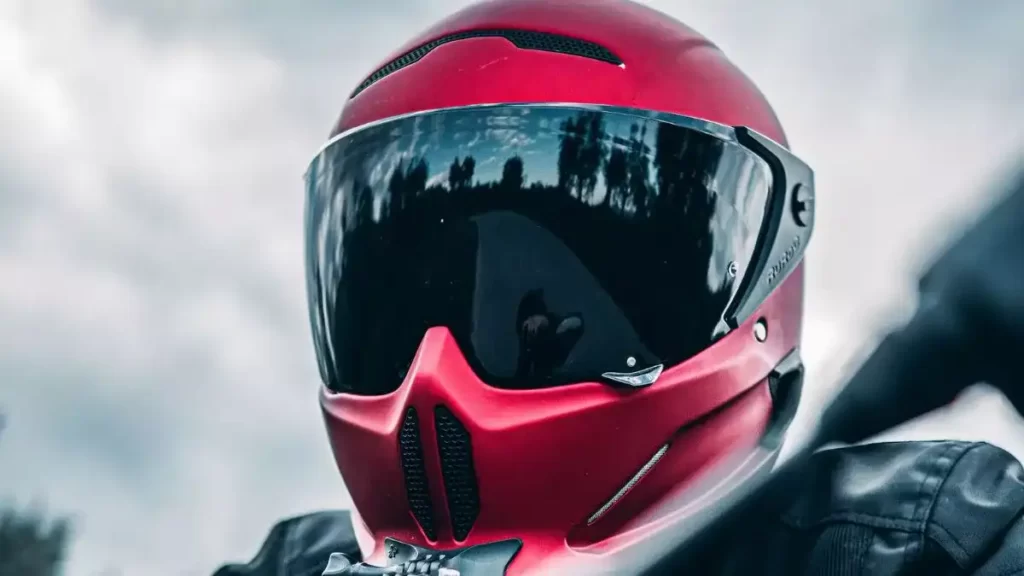
Visors are like cool shields that protect your eyes when you’re riding a motorcycle.
They cover the front part of your helmet and keep stuff like bugs, dust, and stones from hitting your eyes.
You know how the sun can be super bright and make it hard to see?
Well, visors also have different shades to block the sun’s annoying glare and make your vision clearer.
Some visors have special powers.
They can resist scratches, so they stay clear and don’t get blurry.
And there are even visors that change colors depending on how bright it is outside.
They’re like magical lenses that make it easier for you to see when it’s sunny or dark.
Visors are important because they keep your eyes safe while you ride.
They make sure you can see clearly without squinting or worrying about stuff flying into your eyes.
So, with a good visor on your helmet, you can ride confidently and enjoy your adventure on the road.
Types of Helmet Visors
When it comes to the types of helmet visors, there are many options to consider, but mainly, only a few visors are commonly found in the helmet market.
Here are the most common helmet visors to consider:
1. Clear Visor
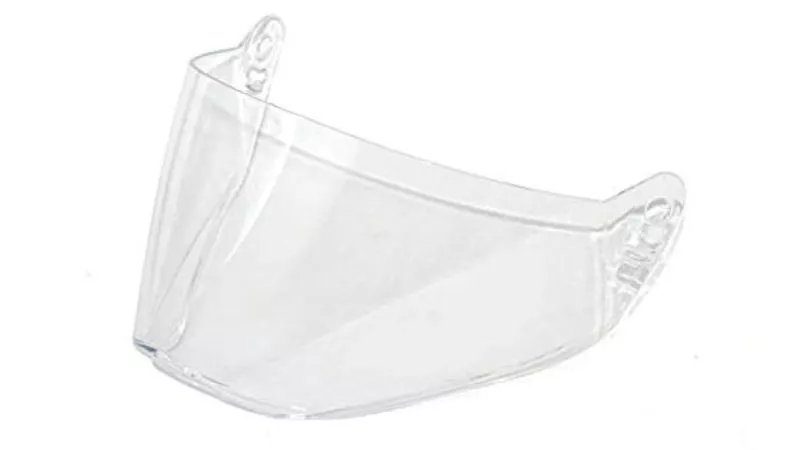
Clear visors are just like clear windows on your motorcycle helmet.
They’re see-through, which means you can look right through them without any fancy colors or dark shades.
Clear visors are the most popular choice among riders because they give you the clearest view of the road ahead.
One of the cool things about clear visors is that they let in the most light.
That means you can see really well, even when it’s super bright outside.
So, if you want a visor that lets you see everything clearly and brings in lots of light, a clear visor is the way to go.
Pros
- Clear and unobstructed view of the road, allowing you to see everything clearly.
- Let in the most amount of light, making them suitable for riding in various lighting conditions.
- Versatile and suitable for day and night riding without compromising visibility.
Cons
- Do not provide protection against bright sunlight or glare, so they may not be ideal for very sunny conditions.
- May not offer the same level of privacy as tinted or mirrored visors.
- Can sometimes reflect light, causing slight distractions or glare.
- Can strain your eyes during long rides on sunny days.
2. Smoke Visor
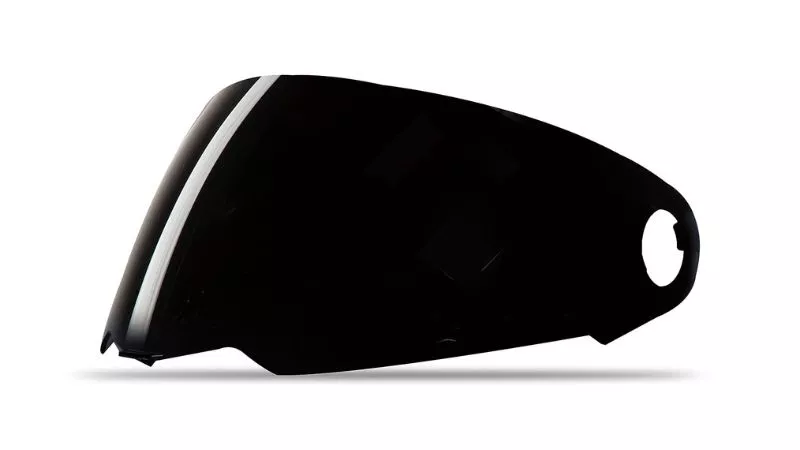
Smoke visors are like having cool sunglasses for your motorcycle helmet.
They’re not too dark, but they have a slight tint that makes everything look a little bit darker.
You know what’s great about smoke visors?
They’re like your secret weapon against glare and bright sunlight.
They help reduce that annoying glare that can make it hard to see when the sun is shining really bright.
The best part is that smoke visors still let you see pretty well.
They don’t block out too much light, so you can still have a good view of the road ahead.
If you’re someone who loves riding on sunny days but doesn’t want the sun to blind you, a smoke visor is a great choice.
Just remember, when it starts to get dark, you might want to switch to a clear visor for better visibility.
Pros
- Reduce glare from the sun, making it easier to see clearly in bright conditions.
- Provide some level of sun protection for your eyes, reducing strain and discomfort.
- Add a stylish and cool look to your helmet.
Cons
- Can make it harder to see in low-light or dark conditions.
3. Mirror/Mercury Visor
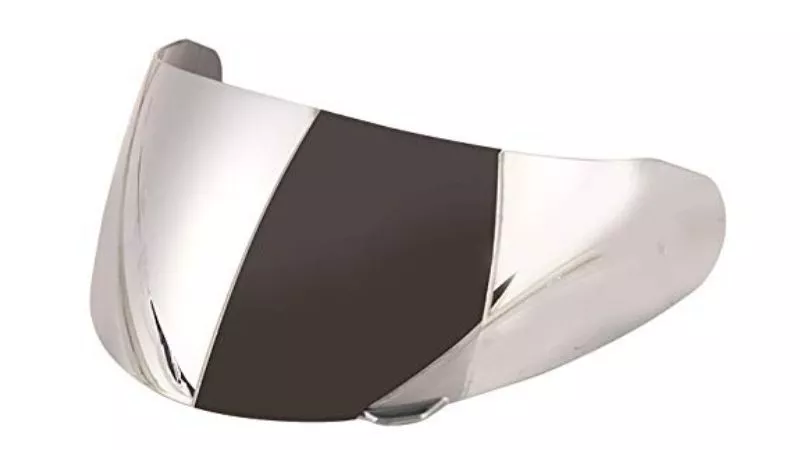
Mirror or mercury visors are like having a futuristic shield on your motorcycle helmet.
They’re not your ordinary visors – they’re something straight out of a sci-fi movie.
You know what makes them so special?
They have this magical reflective coating that creates a mirror-like or mercury-like effect.
Mirror or mercury visors don’t just make you look awesome, they also protect your eyes.
They act as a shield against the sun’s rays, reducing glare and keeping your vision clear and comfortable.
Just imagine riding down the road with a visor that reflects everything like a mirror.
It’s like having a stylish and high-tech accessory for your helmet.
People will definitely turn their heads when they see you riding by.
So, if you want to add some futuristic flair to your helmet and have a visor that not only protects your eyes but also makes you look like a superhero, a mirror or mercury visor is the way to go.
Pros
- Provide excellent protection against sunlight and glare, reducing eye strain.
- Offer a high level of privacy by reflecting your surroundings, making it harder for others to see your eyes.
- Enhance the overall style and aesthetic of your helmet with their distinctive mirror/mercury effect.
Cons
- Can be more expensive compared to other types of visors.
- May not be suitable for riding in low-light or dark conditions due to their dark tint.
- The reflective coating may scratch more easily than other types of visors, requiring careful maintenance.
4. Rainbow Visor
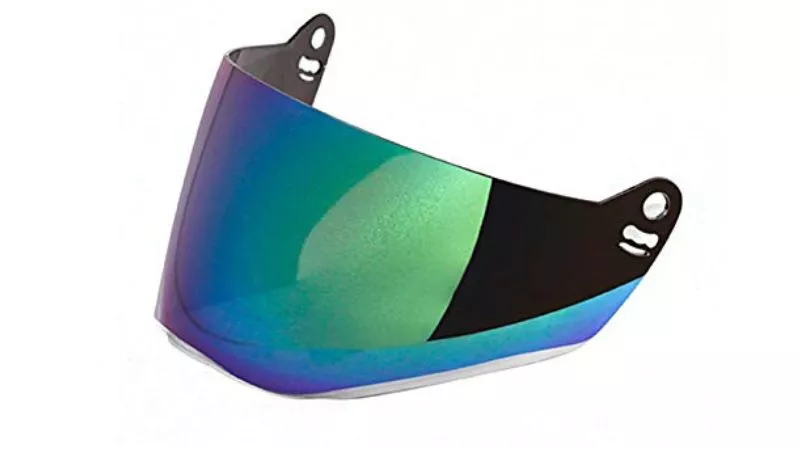
Rainbow visors are like having special lenses on your motorcycle helmet.
They have a special coating that makes them shimmer with all the colors of the rainbow.
When light hits the visor from different angles, it creates a stunning display of colors that will make your helmet look incredibly cool and eye-catching.
Just imagine riding down the road with a visor that sparkles and shines with a whole spectrum of colors.
It’s like wearing a piece of art on your helmet.
Rainbow visors don’t just make your helmet look awesome, they also protect your eyes from bright sunlight.
They act like a shield, blocking out the harsh light and reducing glare, so you can see clearly and ride comfortably.
So, if you want to add some magic and make your helmet stand out from the crowd, a rainbow visor is the perfect choice.
Pros
- Create a unique and vibrant look for your helmet, making you stand out from the crowd.
- Offer some level of sun protection by reducing glare and bright reflections.
- Enhance your style and add a touch of personality to your riding gear.
Cons
- Can be more expensive compared to other types of visors.
- The iridescent effect may not be suitable for everyone’s taste.
5. Night Vision Visor
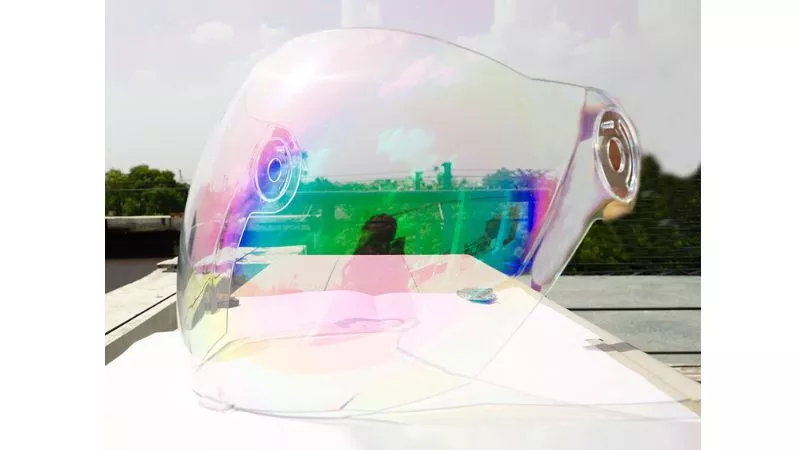
Night vision visors are like super goggles for your motorcycle helmet that help you see in the dark.
They use fancy technology to make it easier for you to see things when it’s really dark and there’s not much light around.
It has a special power that enhances your vision, kind of like wearing a pair of glasses that make everything clearer.
With a night vision visor, you can spot things that would normally be super hard to see in the dark.
It’s like having your own secret superpower to see in the night.
So, if you love riding your motorcycle when the sun goes down and want to see better in the dark, a night vision visor is what you need.
Pros
- Enhance your vision in low-light or nighttime conditions, allowing you to see things that would normally be difficult to detect.
- Improve safety by increasing your awareness of potential hazards on the road.
- Can make nighttime rides more enjoyable and less stressful, as you’ll have better visibility.
Cons
- Night vision visors can be quite expensive compared to regular visors.
- They may have a limited field of vision.
6. Photochromic Visor
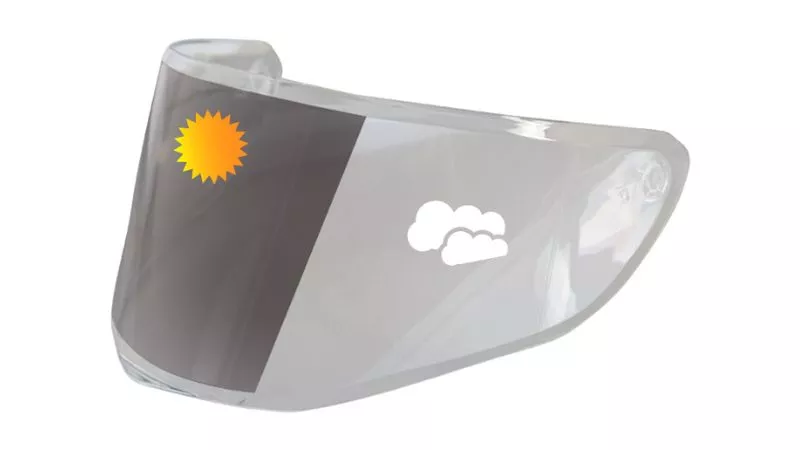
Photochromic visors are special visors for motorcycle helmets that automatically adjust their tint based on the amount of sunlight they receive.
When the sun is super bright, the visor darkens to reduce glare and protect your eyes from the intense light.
And when it’s cloudy or the sun goes down, the visor becomes lighter, allowing more light to come through so you can see better.
So, with a photochromic visor, you don’t have to worry about manually changing visors or squinting your eyes in bright sunlight.
It’s like having a magical shield for your eyes that adjusts itself to the perfect tint depending on the light conditions.
Whether you’re riding in the daytime, nighttime, or in changing weather conditions, a photochromic visor is your best friend.
It ensures your eyes are protected and gives you optimal visibility no matter the lighting situation.
Pros
- Adapt to different lighting conditions, making them versatile for day and night riding.
- Provide protection against bright sunlight and glare, reducing eye strain.
- Eliminate the need to switch between different visors as they adjust their tint automatically.
Cons
- They can be more expensive compared to regular visors.
- The transition between tints may not be instant, taking a few moments to adjust.
- Extreme changes in lighting conditions may require additional time for the visor to fully adapt.
Visor Retention Systems
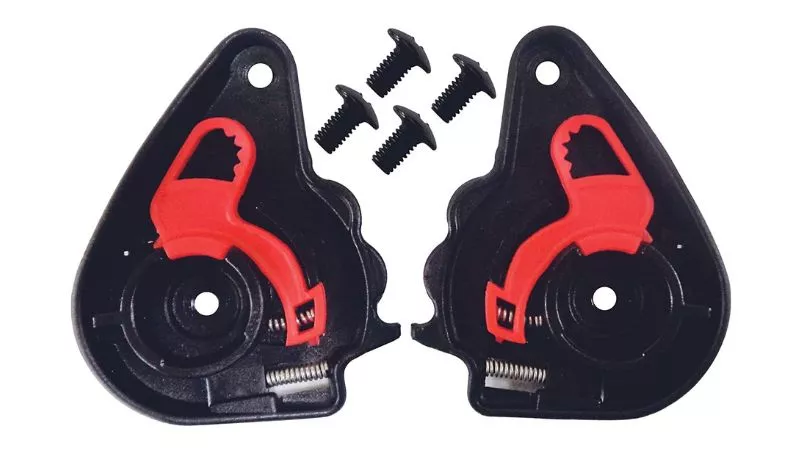
The visor retention system is like a special lock that keeps the face shield of your helmet securely in place.
It ensures that the shield doesn’t come off while you’re riding and protects your eyes.
There are different types of visor retention systems, such as the “click and lock” mechanism.
It allows you to easily click the visor into place, securing it tightly.
There’s also the “quick-release” system, which lets you remove the visor quickly when needed.
Some visor retention systems use springs or magnets to keep the visor secure, even during bumpy rides.
And if you choose a budget helmet, it may come with a screw-type visor retention system.
This type of system is commonly used in budget helmets and can be a bit more challenging to operate compared to other types.
Instead of using quick-release mechanisms or click-and-lock systems, a screw-type visor retention system involves manually tightening or loosening screws to secure or remove the visor.
While this system may be more affordable, it requires additional effort and time to adjust the visor.
You need to use a screwdriver or similar tool to tighten or loosen the screws, which can be a bit inconvenient compared to systems that offer quicker and easier visor changes.
And that’s why, when it comes to the visor retention system, I always prefer the quick-release system.
Visor Maintenance and Care
Helmet visor maintenance and care are a must, no matter how often you use your helmet.
So, I’m going to share how I take care of my visors to ensure their long lifespan.
- Clean with care: Use a soft, lint-free cloth or a microfiber cloth to clean the visor. Avoid using abrasive materials or harsh chemicals that can scratch or damage the surface.
- Use mild soap: If your visor is dirty, you can gently wash it with a mild soap and lukewarm water. Rinse thoroughly and pat dry with a soft cloth.
- Avoid rough handling: Handle the visor with clean hands and avoid touching the inside surface to prevent smudges and fingerprints.
- Store properly: When not in use, store the helmet with the visor in a protective bag or case to prevent scratches and dust accumulation.
- Avoid extreme temperatures: Avoid exposing the visor to extreme heat or cold, as it can cause damage or distortion. Store the helmet in a cool, dry place.
- Check for damage: Regularly inspect the visor for any cracks, scratches, or signs of wear. If you notice any damage, consider replacing the visor for optimal safety.
- Replace when necessary: Visors have a limited lifespan, so if you notice significant wear, distortion, or damage that affects visibility, it’s essential to replace the visor with a new one.
Remember, proper visor maintenance and care ensure clear visibility and extend the lifespan of your helmet visor, keeping you safe on your rides.
The Bottom Line
The visor is not just a piece of plastic or glass—it’s your window to the world as you ride.
It shields your eyes from wind, dust, debris, and harsh sunlight, making your journey safer and more enjoyable.
Whether you choose a clear visor for a crystal-clear view or a smoke visor to battle glare, each type has its own special powers.
Mirrored visors bring style, while photochromic visors adjust to the lighting conditions.
Just like any superhero gear, your visor needs proper maintenance.
Give it a gentle cleaning with a soft cloth, handle it with care, and store it in a safe place when not in use.
These little acts of love will ensure its long and heroic lifespan.
So, choose wisely, keep it clean, and enjoy the thrill of the open road with a reliable visor by your side.
You might be interested in these guides.
Frequently Asked Questions
What is a helmet visor?
A helmet visor is a protective shield that attaches to the front of a motorcycle helmet. It serves as a barrier between the rider’s eyes and the external elements, such as wind, debris, sunlight, and glare.
What are the different types of helmet visors available?
Common types of helmet visors include clear visors, smoke visors, mirrored visors, photochromic visors, and tinted visors. Each type offers specific benefits, such as visibility enhancement, glare reduction, or stylish appearance.
What is a tinted visor?
A tinted visor is a type of helmet visor that has a dark tint or shade applied to the surface. The tint helps reduce glare from the sun and bright light, providing added comfort and eye protection during sunny riding conditions.
Are helmet visors interchangeable between different helmet brands?
In most cases, helmet visors are designed to be compatible within the same brand and model line.
How often should I replace my helmet visor?
The lifespan of a helmet visor varies depending on factors such as usage, care, and exposure to environmental conditions. It is generally recommended to replace a visor every 2-5 years or sooner if it shows signs of damage, significant scratches, or reduced visibility.
How do I clean my helmet visor?
To clean your helmet visor, use a soft, lint-free cloth or a microfiber cloth to gently wipe away dirt or smudges. If needed, you can use mild soap and lukewarm water for more thorough cleaning. Avoid abrasive materials or harsh chemicals that may scratch or damage the visor.
Can I replace a visor myself?
Many helmet visors are designed for user-replacement, and the process typically involves following the manufacturer’s instructions. However, if you are unsure or uncomfortable with the process, it is recommended to consult a professional or the helmet manufacturer for assistance.
Can I use aftermarket visors on my helmet?
Using aftermarket visors is possible, but it is crucial to ensure compatibility and safety. It is recommended to choose visors specifically designed for your helmet model or consult the manufacturer for guidance on aftermarket options.
Can I wear sunglasses with my helmet visor?
Yes, you can wear sunglasses with your helmet visor. However, it is important to ensure that the sunglasses fit comfortably and do not interfere with the proper fit and function of the helmet or the visor.
Can I customize the colour or design of my helmet visor?
Some helmet manufacturers offer customization options for visors, allowing you to choose different colours or designs. However, it is important to check whether such modifications comply with safety regulations and do not compromise visibility or structural integrity.